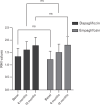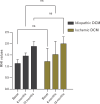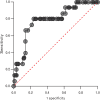Impact of SGLT2 inhibitors on endothelial function and echocardiographic parameters in dilated cardiomyopathy
- PMID: 40472172
- PMCID: PMC12404634
- DOI: 10.2459/JCM.0000000000001733
Impact of SGLT2 inhibitors on endothelial function and echocardiographic parameters in dilated cardiomyopathy
Abstract
Background: Dilated cardiomyopathy (DCM) is a common cause of heart failure with reduced ejection fraction (HFrEF) in industrialized countries and a major contributor to morbidity and mortality. Sodium-glucose cotransporter-2 inhibitors (SGLT2i) have demonstrated significant benefits in HFrEF management; however, their impact on endothelial function in this patient population remains less explored. This study aims to evaluate the effects of SGLT2i on endothelial function and echocardiographic parameters in patients with DCM.
Methods: This observational, longitudinal, monocentric study enrolled patients with DCM and HFrEF. Endothelial function was assessed using peripheral arterial tonometry (EndoPAT) at baseline, 6 months, and 12 months following the initiation of sodium-glucose cotransporter-2 inhibitors (SGLT2i). The enrollment period spanned from November 2021 to November 2022. The primary endpoint was the change in reactive hyperemia index (RHI) over time. In addition, a subgroup analysis was conducted to compare the effects of different SGLT2i agents (empagliflozin vs. dapagliflozin) and DCM etiology (ischemic vs. idiopathic) on endothelial function.
Results: A total of 102 patients were included, predominantly male (72%), with a median age of 75 years and an average baseline left ventricular ejection fraction (LVEF) of 32.9 ± 7.9%. NYHA class II/III was observed in 76% of participants, and ischemic etiology accounted for 53% of DCM cases. The baseline RHI value was 1.15 ± 0.34. At 6 months, it significantly increased to 1.40 ± 0.34 (P < 0.0001), reflecting an absolute change of 0.25 ± 0.03 (ΔRHI baseline - 6 months). Between 6 and 12 months, the RHI showed a further significant increase to 1.69 ± 0.36 (P < 0.0001), with an additional change of 0.29 ± 0.03 (ΔRHI 6 - 12 months). The overall change in RHI from baseline to 12 months (ΔRHI baseline - 12 months) was 0.54 ± 0.04 (P < 0.0001). No significant differences in RHI were observed between patients treated with dapagliflozin and those receiving empagliflozin (P = 0.589), nor between different DCM etiologies (ischemic vs. idiopathic, P = 0.463). The enhancement in RHI was associated with a reduction in the incidence of hospitalization for heart failure (AUC 0.783, P < 0.001). Progressive improvement in left ventricular function was observed through echocardiographic parameters. Although EDV and ESV showed a decreasing trend (EDV: 176.2 ± 64.9 to 167.6 ± 31.1 ml, P = 0.335; ESV: 124.5 ± 52.7 to 116.8 ± 24.6 ml, P = 0.606), these changes were not statistically significant. LVEF improved significantly from 32.9 ± 7.9% at baseline to 36.8 ± 5.5% at 6 months and 37.1 ± 4.9% at 12 months (P < 0.001). The E/A ratio declined from 1.5 ± 0.5 to 1.1 ± 0.3 (P = 0.023) and the E/E' ratio decreased from 18.1 ± 5.1 to 11.1 ± 2.8 (P = 0.027).Left atrial volume significantly decreased from 108 to 100 ml (P = 0.041), and pulmonary artery systolic pressure dropped from 44 to 39 mmHg at 6 months and 35 mmHg at 12 months (P < 0.001).
Conclusion: SGLT2i therapy significantly improves endothelial function in patients with DCM suggesting a potential vascular benefit beyond their well established cardioprotective effects.
Keywords: EndoPAT; dilated cardiomyopathy; echocardiography; endothelial function; heart failure; heart failure with reduced ejection fraction; sodium-glucose cotransporter-2 inhibitors.
Copyright © 2025 Italian Federation of Cardiology - I.F.C. All rights reserved.
Conflict of interest statement
There are no conflicts of interest.
Figures






Similar articles
-
Dapagliflozin effect on functional mitral regurgitation and myocardial remodelling: The DEFORM trial.ESC Heart Fail. 2025 Aug;12(4):2866-2877. doi: 10.1002/ehf2.15296. Epub 2025 Apr 10. ESC Heart Fail. 2025. PMID: 40207405 Free PMC article. Clinical Trial.
-
Effects of dapagliflozin and empagliflozin on 6-min walk distance in heart failure with preserved and reduced ejection fraction: A systematic review and meta-analysis of randomized controlled trials involving 2624 patients.Eur J Clin Pharmacol. 2024 Jul;80(7):951-963. doi: 10.1007/s00228-024-03660-2. Epub 2024 Mar 18. Eur J Clin Pharmacol. 2024. PMID: 38498097
-
Dapagliflozin and Right Ventricular-Pulmonary Vascular Interaction in Heart Failure With Preserved Ejection Fraction: A Secondary Analysis of a Randomized Clinical Trial.JAMA Cardiol. 2024 Sep 1;9(9):843-851. doi: 10.1001/jamacardio.2024.1914. JAMA Cardiol. 2024. PMID: 39046727 Free PMC article. Clinical Trial.
-
Prescription of Controlled Substances: Benefits and Risks.2025 Jul 6. In: StatPearls [Internet]. Treasure Island (FL): StatPearls Publishing; 2025 Jan–. 2025 Jul 6. In: StatPearls [Internet]. Treasure Island (FL): StatPearls Publishing; 2025 Jan–. PMID: 30726003 Free Books & Documents.
-
Empagliflozin and other SGLT2 inhibitors in patients with heart failure and preserved ejection fraction: a systematic review and meta-analysis.Ther Adv Cardiovasc Dis. 2024 Jan-Dec;18:17539447241289067. doi: 10.1177/17539447241289067. Ther Adv Cardiovasc Dis. 2024. PMID: 39400108 Free PMC article.
References
-
- Arbelo E, Protonotarios A, Gimeno JR, et al. 2023 ESC Guidelines for the management of cardiomyopathies. Eur Heart J 2023; 44:3503–3626. - PubMed
-
- Reichart D, Magnussen C, Zeller T, Blankenberg S. Dilated cardiomyopathy: from epidemiologic to genetic phenotypes: a translational review of current literature. J Intern Med 2019; 286:362–372. - PubMed
-
- Zuin M, Rigatelli G, Porcari A, et al. Trends in age and sex-specific dilated cardiomyopathy mortality in Italy, 2005-2017. J Cardiovasc Med 2023; 24:530–536. - PubMed
Publication types
MeSH terms
Substances
LinkOut - more resources
Full Text Sources

